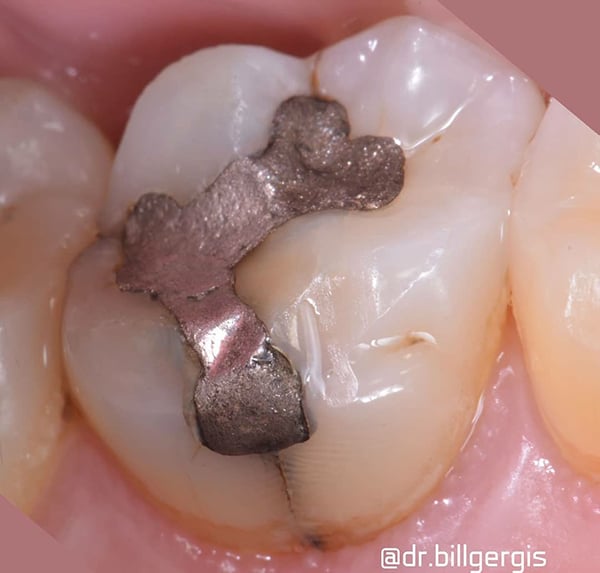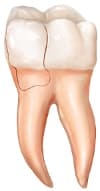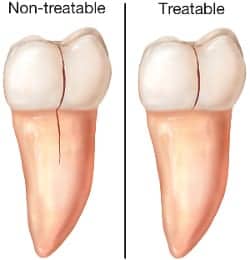There are several different types of cracked teeth. Generally, when a tooth has a large filling, it can be more susceptible to cracks as it can be structurally weaker. The treatment and outcome for your tooth depends on the type, location, and extent of the crack, as well as your bite.
Craze Lines
Craze lines are the smallest of cracks. These are tiny cracks that affect only the outer enamel and extremely common in adult teeth. Craze lines are very shallow, and often do not cause any symptoms or pain. Oftentimes, they are insignificant and no treatment is required.

Fractured Cusp/s
When the pointy part of the tooth (the cusp) becomes weakened (as a result most often from large fillings and/or malocclusion), a fracture can sometimes result. The weakened cusp may break off by itself or may have to be removed by the dentist. After such a break or removal, usually the tooth can be saved. In a few instances after this occurs, root canal therapy might be needed if the fracture occurred too closely to the “nerve.” If a root canal is needed, or it is not needed, it is strongly recommended that your tooth be restored with a full crown by your dentist.

Cracked Tooth
A cracked tooth has a crack that extends from the chewing surface of the tooth vertically towards the root tip. A cracked tooth may not completely be separated into two distinct segments. Nevertheless, these types of long-standing cracks often damage the pulp (“nerve”). Root canal treatment is often needed to treat the injured pulp and alleviate your symptoms (if symptomatic). After root canal therapy, your dentist will restore your tooth with a crown to keep the splinted pieces together thereby protecting the cracked tooth. In such cases when the crack extends below the gingiva (“gums”), such a crack *might* require tooth extraction. If you opt to save the tooth regardless of the crack, these cases do not have a favorable long-term prognosis. Early diagnosis is critical. Even with high-magnification, lighting, operating microscopes and technology, it can be difficult to determine the extent of a crack. But, a cracked tooth that is not treated will progressively worsen, eventually resulting in only one option for the tooth – extraction and loss of the tooth. Early diagnosis and treatment are essential in saving these teeth.

Split Tooth
A split tooth, unfortunately, is often the result of the long-term progression of a cracked tooth. The split tooth is identified by a crack with distinct segments that can be separated; both segments are often mobile. Oftentimes, a split tooth cannot be saved. Depending upon the position and extent of the crack as sometimes it can be an oblique split that does not extend all the way down the root, however, will determine whether any portion of the tooth can be saved. In some cases, endodontic treatment may be performed to save a portion of the tooth. Dr. McIntyre can usually determine the extent through investigation by removing the filling and observing the extent of the crack/split. When possible, she will save the tooth offering prognosis first and a discussion about the long-term needs of the tooth. If not possible, she will refer you either back to your dentist or a specialist for the tooth’s removal and/or replacement with an implant.

Vertical Root Fracture
Vertical root fractures are cracks that begin in the root of the tooth and extend toward the chewing surface. They often show minimal signs and symptoms and may, therefore, go unnoticed for some time. Vertical root fractures are often discovered when the surrounding bone and gum become infected. Treatment may involve extraction of the tooth. However, endodontic surgery is sometimes appropriate if a tooth can be saved by removal of the fractured portion. A 3D image of the tooth may be required to obtain more diagnostic information if your tooth/root is vertically fractured.


